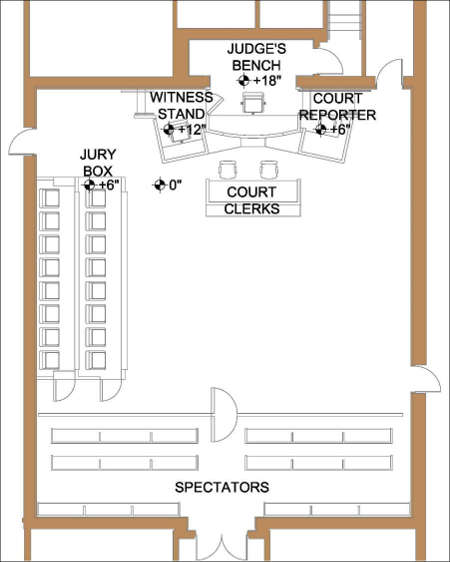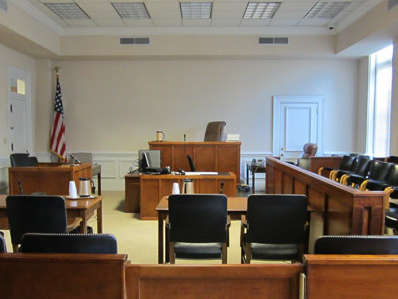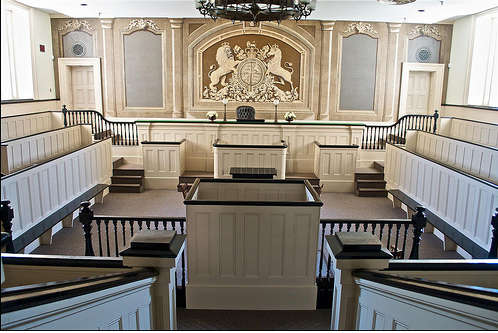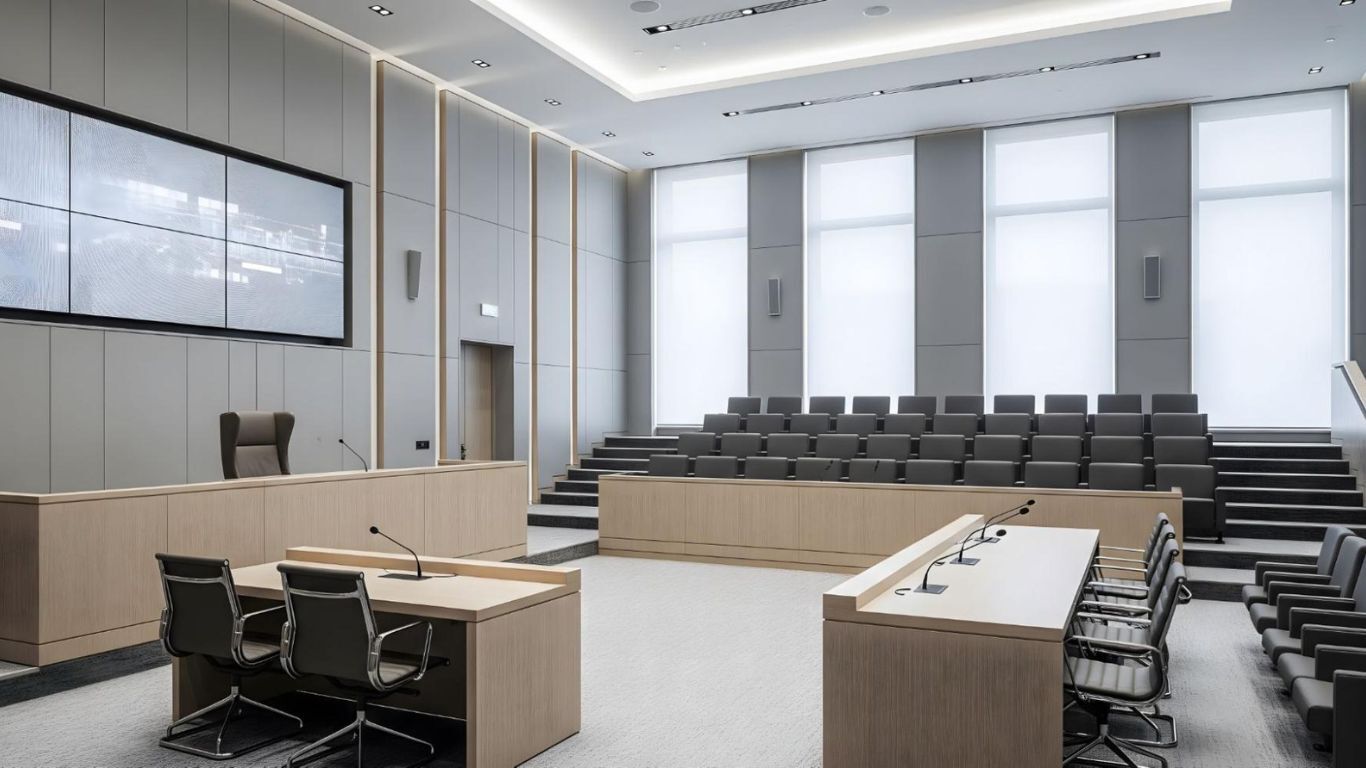The witness represents a critical player in the judicial process. How that witness is presented in court is, in part, established by the location of the witness stand, the stage upon which their testimony is given, and then received by the judge, jury, litigants, attorneys, and spectators.
This article reviews how varying witness stand locations affect that presentation and gives courtroom planning and court officers options for implementing their concepts of witness testimony.
As an architect involved in courthouse planning and courtroom design analysis, I understand that the attention paid to the specific aspects of a courtroom layout and design can affect how future participants in judicial proceedings perceive each other and may help generate appropriate reactions from each participant.
Measuring its Importance - Literally
In a contemporary courtroom layout and design, the witness stand’s prominence is second only to the judge’s bench, as shown in the floor plan below. Most courtroom design standards set the level of the judge’s bench highest above the rest of the participants in a proceeding.
The floor of the judges’ bench is usually 18 to 24 inches above the courtroom floor to impress upon the participants and spectators that the judge is the individual who has authority over the proceedings (and to provide the judge with sufficient sightlines in the courtroom).
The witness stand is given the second highest level at 6 to 12 inches above the courtroom floor. In contrast, the jury box is given a third level of prominence, with the front row at the same level as the courtroom or 6 inches above the floor.

For example, courtroom layout and elevations
This relative prominence among the court participants is meant to impart importance to the witness and the witness’ testimony. Along with the height above the courtroom floor, the design and location of the witness stand also aid in conveying the importance of the witness because it is not only the spoken testimony that is of relevance to the other members of the proceedings but also the nonverbal communication displayed by the witness through demeanor and facial expressions.
The witness stand typically has a countertop, microphone, comfortable chair, and a modesty panel for promoting a sense of ease in the witness. The countertop provides a surface upon which evidentiary materials can be laid (or a computer monitor in a courtroom with evidence presentation technology) and a buffer zone separating the witness from the examining attorney, adding to the comfort of the witness.
Location, Location, Location
In my experience visiting numerous courthouses over the years, the most common location of the witness stand has been adjacent to the judge. This proximity to the judge adds to the witness's level of importance in the other participants' eyes. It affords the judge some ease in instructing the witness when necessary.

Typical Witness Stand and Judges’ Bench Viewed from the Jury Box
It’s essential not to put the witness stand too close to the jurors, considering that a witness may exhibit hostility that could be intimidating to some nearby jurors. Having a physical barrier, like a low wall, is also vital between the witness and the judge.
While this most common location is directly next to the judge is desirable, one drawback is that the judge and some jurors do not have a full facial view of the witness but are mostly limited to a side view.
I have also seen courtroom layouts where the witness stand was located on an island in the well area of the courtroom, physically separated from the judge’s bench, often opposite the jury box. This placement could provide a more direct view of the face of the witness for both the judge and the entire jury, such as the Tennessee example shown below.

Witness Stand Opposite the Jury Box, Tennessee
Just as being seated in proximity to the judge can add prominence to the witness, in this alternative layout, the fact that the witness stand is separate from the bench can also, in its own way, add to the perceived importance of the testimony, accentuated by having all eyes on this focal point. However, this could also serve to make a witness feel unduly vulnerable.
The concept for the placement of the witness stand detached from the bench is reminiscent of the historical roots of the American courtroom. In the historic Virginia courtroom pictured below, the witness is seated in a chair that offers a full view of any nonverbal communication through body language. This “island witness stand” is conceptually similar to the British courtroom shown below, where the witness is prominently displayed on a dais facing the judge, jury, litigants, and attorneys. However, one flaw with this arrangement for the modern American courtroom is that the witness is turned away from the spectators; in the transparency of today’s judicial system, the public should be given a share of the view of the face of the witness.

Historic Virginia Courtroom

Historic British Courtroom, London

Witness Stand Opposite the Jury Box, North Carolina
This open-style concept where the witness is fully displayed can still be found in some modern courtrooms. During a recent site visit, I asked a North Carolina court officer about the relatively unique location of the witness stand shown in the above photo. The officer explained that the arrangement of this witness stand was explicitly intended to make the witness feel exposed, unprotected, and perhaps a little intimidated. The assumption was that the witness would be more apt to speak their mind – or maybe “speak only the truth.” I sat in that chair, and even without cross-examination, I experienced all those feelings.
My Take on Witness Stand Location
As a courthouse planner and designer, I am not entirely in accord with the belief that a witness should be “naked and afraid” when giving testimony. This may only make that witness so intimidated that they are less forthcoming. However, I can understand that there is value in the other participants in the proceedings having an unencumbered view of the witness, to not only hear the testimony but to see and “read” the witness fully.
Today's more typical layout with the witness directly adjacent to the judge’s bench is a viable compromise in these differing witness stand philosophies. It provides a witness stand in the raised platform in direct proximity to the judge to provide weight to the testimony, allows a relatively clear view of the facial expression and mannerisms of the witness to convey the equally important nonverbal communications, and partially enclosed and non-isolated to offer a level of ease for the witness.





.jpg)
.jpg)
.jpg)
.jpg)
.jpg)
.jpg)


.jpg)
.jpg)


